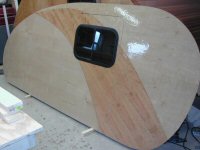My basic idea is to build a 5x10 teardrop using the general profile of the ATMA Travelear.
The thing that makes my project unique is that I'm planning on using homebuilt aircraft composite construction technology involving moldless fiberglass/foam/epoxy. I've pushed the numbers and I think I can build mine at about 300-350# empty. I'm not planning on using any wood in the project, except for some small structural "pads" for the mounting of the axles...and I'm not going to be using a frame either. The tongue is part of the floor structure and the axles attach directly to the floor (see image below).
A typical 4x8 sheet of 3/4 plywood weighs 75-80 lbs. A comparable composite structure of 1" styrofoam covered in 2ply BID (bidirectional fiberglass) on each side, will weigh 16 lbs. My cabinets and bulkheads will also be composite so there is significant weigh savings there as well. My tongue will be aluminum estimated to weigh 7-8# plus whatever the receiver weighs.
This kind of construction is extremely strong as evidenced by this image of bags of shot piled on a Long EZ canard.

The upper structure is a no-brainer as foamies constructed out of foam, canvas and paint are quite common and seem to survive nicely. Since I'm not going with a frame, but rather a monocoque design, the floor structure needs to be pretty stout. The plan here is to use 2" foam covered in 2ply BID with the equivalent of a shear web constructed of BID laid up at a 45 and spar caps constructed from UNI (unidirectional fiberglass) on 2' centers. This will provide the primary structural rigidity from edge to edge while the walls and bulkheads will provide additional structural rigidity and strength to the sides. Walls, roof, doors and hatch are 1" foam with 2ply BID per side. Structural bulkheads are 1" foam and non structural bulkheads are 1/2" foam, or possibly 3/8" nomex honeycomb.
The tongue storage box is an integral structure to the main trailer structure.
I plan on using torsion axles, half or full depending on factors yet to be determined. I plan on 13" alloy wheels and fiberglass fenders.
I don't planning on pulling 6g's and if something breaks it won't be at 10,000 ft so I think my design is sound and adequate for the intended use. If I do come in at 350# empty and run at 450-500# or so, that gives me a tongue weight of about 50#.
Some may say a trailer can be too light. That has yet to be proven, but if it does prove to be a problem, I'm prepared to add ballast tanks that can be filled during high wind situations. In fact, if you notice the area under the lower shelf in the front, this could be the front ballast tank easily and and a second one at the galley bulkhead would get me additional weight.
The intended tow vehicle is my 380SL Mercedes in which I installed a diesel engine. I get 33mpg on the open road, so by keeping the wind resistance and weight down, I hope to keep the tow penalty to a minimum. Plus the light weight means there will be plenty of excess capacity in the hitch.
Here are some current design images.

















 .
.